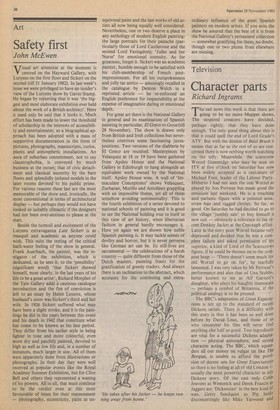Art
Safety first
John McEwen
VTisual art attention at the moment is V centred on the Hayward Gallery, with Lutyens on the first floor and Sickert on the second (till 31 January 1982). In last week's issue we were privileged to have an insider's view of the Lutyens show by Gavin Stamp. He began by reporting that it was 'the biggest and most elaborate exhibition ever held about the work of a British architect'. Here it need only be said that it looks it. Much effort has been made to lower the threshold of scholarship in the interests of accessibility and entertainment; so a biographical approach has been adopted with a mass of supportive documentation in the form of pictures, photographs, manuscripts, curios, plants and atmospheric installations. An aura of suburban contentment, not to say claustrophobia, is conveyed by much business at the outset; that of civic detachment and classical austerity by the bare floors and splendidly isolated models in the later rooms devoted to his public prime. For various reasons these last are the most memorable of the show and, ironically, the most conventional in terms of architectural display — but perhaps they would not have looked so suitably climactic if the designers had not been over-anxious to please at the start.
Beside the turmoil and excitement of the Lutyens extravaganza Late Sickert is as tranquil and academic as anyone could wish. This suits the testing of the critical bath-water feeling of the show in general. Frank Auerbach, the painter, was the instigator of the exhibition, which is dedicated, as he sees it, to the 'possibility' (significant word) 'that Sickert showed himself, most clearly, in the last years of his life to be a great artist'., Richard Morphet of the Tate Gallery adds a cautious catalogue introduction and the fire of conviction is left to an essay by Helen Lessore, whose husband's sister was Sickert's third and last wife. In 1926 Sickert suffered what may have been a slight stroke, and it is the paintings he did in the years between this event and his death in 1942 that constitute what has come to be known as his late period. They differ from his earlier style in being lighter in tone and more colourful, even more dry and patchily painted, devoted to high as well as low life and, in a number of instances, much larger in size. All of them were apparently done from illustrations or photographs. In their day they were well received at popular events like the Royal Academy Summer Exhibition, but for Clive Bell and others they represented a waning of his powers. All in all, that must continue to be the verdict even at this most favourable of times for their reassessment — photography, eccentricity, paint as un equivocal paint and the last works of old artists all now being equally well considered. Nevertheless, one or two deserve a place in any anthology of modern English painting: the large portraits for their panache (particularly those of Lord Castlerosse and the second Lord Faringdon); 'Juliet and her Nurse' for emotional intensity. As for greatness, forget it. Sickert was an academic painter, humble enough to be satisfied with his club-membership of French postimpressionism. For all his outspokenness and jolly tar antics — amusingly recalled in the catalogue by Denton Welch in a reprinted article — he re-enforced an English preference for respectability at the expense of imaginative daring or emotional depth.
For great art there is the National Gallery in general and its examination of Spanish painting in particular, El Greco to Goya (till 29 November). The show is drawn only from British and Irish collections but nevertheless contrives some fascinating juxtapositions. Two versions of the diablerie by El Greco are reunited. Masterpieces by Velasquez at 18 or 19 have been gathered from Apsley House and the National Gallery in Edinburgh to hang alongside an equivalent work owned by the National itself. Apsley House wins. A wall of 'Immaculate Conceptions' shows Velasquez, Zurbaran, Murillo and Antolinez grappling with an impossible theme, yet all of them somehow avoiding sentimentality. This is the fourth exhibition of a series devoted to national schools of painting and it is good to see the National holding true to itself in this view of art history, when libertarian fashion in general hardly encourages it. Here yet again we are shown how noble Spanish painting is. It may tackle scenes of devilry and horror, but it is never perverse like German art can be. Its still-lives are sacramental — the celebrations of a harsh country — quite different from those of the Dutch masters, painting feasts for the gratification of greedy traders. And always there is an inclination to the abstract, which accounts for the continuing and extra ordinary influence of the great Spanish painters on modern artists. If you miss the show be assured that the best of it is from the National Gallery's permanent collection — somewhat gratifying for them, no doubt, though one or two plums from elsewhere are missing.














































 Previous page
Previous page